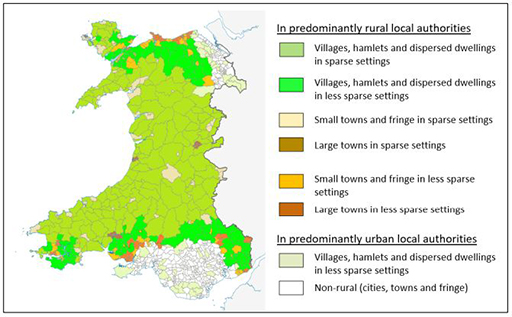4.7 Rural inclusion
In 2021 the rural population in the United Kingdom was about 16%. In the image below, you can see that nearly 82% of Wales is classed as rural, with approximately 32% of the population living in rural areas.

Hybrid working potentially opens up opportunities for people living in rural areas to secure jobs that once were only available to those living in large towns or cities. As organisations embrace more flexible approaches to work, there are many factors that need to be considered to ensure an equal and equitable experience, including considering the cost and feasibility of sustainable commuting. Access to public transport can be limited and some people may have a low economic status.
Digital infrastructure in rural areas is often less developed, so the ability to work effectively remotely can be impacted. Rural communities are finding innovative ways to address this such as the Llanover Digital Inclusion Project (LDIP), [Tip: hold Ctrl and click a link to open it in a new tab. (Hide tip)] to use village halls to provide access to improved broadband provision, raise digital awareness and digital skills in the community, alongside the use of co-working hubs that were explored earlier in the course.
In the video below, Professor Michael Woods – Co-Director, Centre for Welsh Politics and Society – Aberystwyth University, who is one of the co-authors of The Rural Vision for Wales, evidence report, explains the considerations for rural inclusion.

Transcript
Activity 15: 15-minute neighbourhoods
The ‘15-minute neighbourhood concept’ was originally conceived by Carlos Moreno in 2016. His theory focuses on urban areas, with the aim of encouraging regeneration, improving social cohesion, thriving communities, health and wellbeing, while reducing the use of motor vehicles and promoting more sustainable living.
This place-based approach essentially promotes the idea of all residents of all ages and abilities being able to access their daily needs (housing, work, food, health, education, and culture and leisure) within the distance of a 15-minute walk or bike ride.
Reflect on the video above, how could the concept of a 15-minute neighbourhood enable long-term rural inclusion for hybrid working and sustainable ways of working? Make notes in the free text box below.
